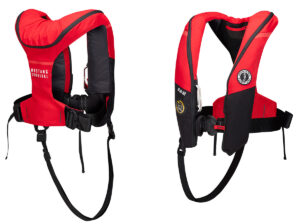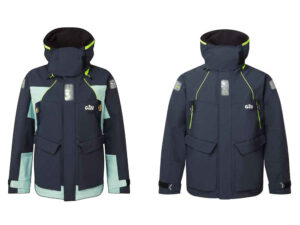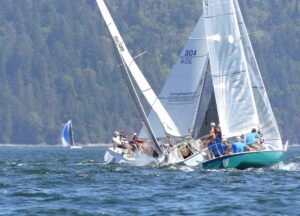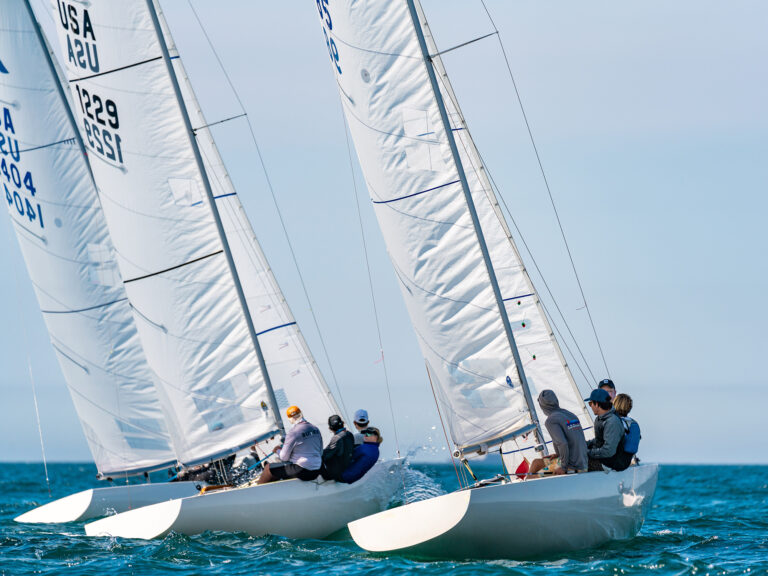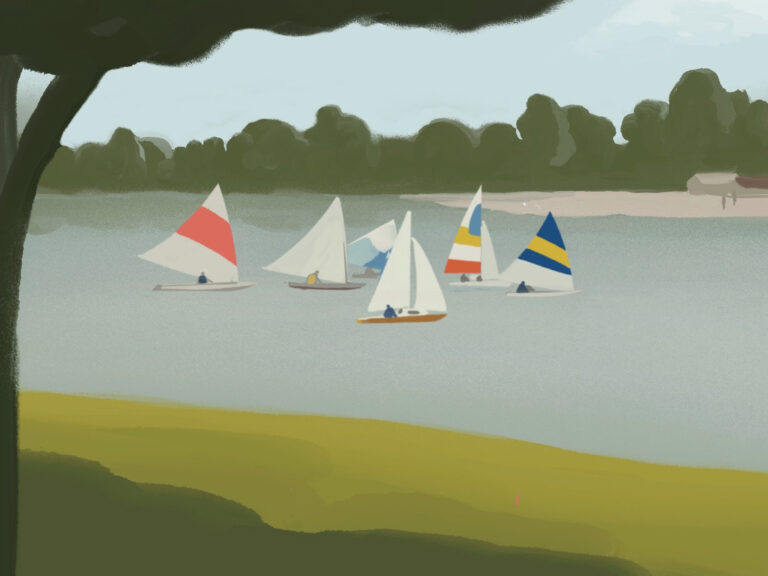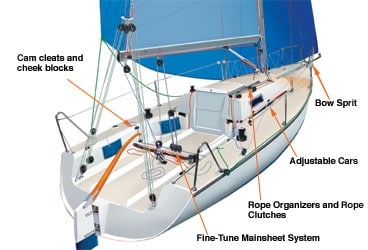
deck update 368
There are many ways to upgrade your boat’s performance, from making sure the bottom is smooth to updating your sail inventory. But what about all that aging deck hardware? Look around your boat and you’re sure to find ways you could improve sail handling and lighten things up with the latest technology. Just one simple change could make your boat faster and easier to sail. But where to begin? We’ll get you going with a few ideas for your next deck hardware upgrade, but don’t let us stop you there.
|| |—| | ****| |****| Let’s start at the bow. Asymmetric spinnakers are a common sight on racecourses these days, and not just on boats that came stock with them. A-sails are easier to jibe, and more efficient than symmetric kites in all but heavy air, when symmetrics can run dead downwind. The most efficient way to carry an A-sail is on a sprit, which gets the spinnaker out and away from the shadow of the main. Modifying your boat to carry a sprit doesn’t necessarily mean cutting a hole in your bow, as several companies now offer kits that allow you to mount a sprit on your deck with a minimum of work.
Instead of two pairs of sheets and guys, not to mention pole up/down controls, a bowsprit-tacked asymmetric sail requires only a tack line and two sheets, which simplifies sailing from the cockpit and requires fewer crew to handle. One of many companies offering custom and semi-production carbon sprits is Forte, which offers a Sprit Kit designed for boats 20 to 50 feet in length. It includes a carbon-fiber sprit engineered to withstand high loads, and a choice of easy-to-mount deck and sail attachment hardware. The Sprit Kit can accommodate boats of varying displacement (from 9,000 lbs., to 36,000 lbs.). The Sprit Kit includes hardware to support the pole, at its outboard end and its inboard end, in one of two ways: For a stationary sprit: one saddle and one inboard end deck fitting, and for a retractable sprit: two saddles. The machine-contoured saddle comes with a removable stainless strap, two threaded rods, and stainless knobs. The bottom profile can be shaped to the contour of the deck. The inboard end deck fitting consists of a Schaefer Marine Quick Connect deck plate, a machined-composite end fitting, and a machined-plastic outboard end cap with through hole for a tack line. The Sprit Kit includes sufficient mounted loupes to fly an asymmetric, a gennaker, or a Code Zero.
Inhaulers are a great way to improve the efficiency of non- or short-overlapping headsails that can be trimmed inside the chainplates. “Due to the high aspect nature of a typical LP jib, an inhaul system greatly increases its range by offering a method of shaping the flat foot while not losing leach tension,” says Harken’s Jim Anderson. “I would recommend a Dyneema strop dead ending on a padeye just aft of the mast, running outboard through a 5/16″ ring (through which the sheet will run) and back inboard through a foot block at the forward corner of the spray hood to turn it aft toward the aft end of the cabin. From there I would recommend using a 5-to-1 purchase off the strop using fiddle blocks. The tail of the purchase could be lead to an angled fairlead and cam combination.”
While you’re improving your jib’s sheeting angle, and if you still have pin-set jib tracks, it’s time to get adjustable lead changers, which can substantially improve the way your crew changes gears during windspeed ups-and-downs. Instead of waiting until the next tack to change the jib leads, headsail trimmers can adjust their leads even when the sheet is loaded with a properly set up adjustable lead changer. Low-stretch line is essential for these systems. Schaefer, Harken, and other hardware manufacturers offer upgrade packages, which will work with your existing track, but will require the installation of footblocks, control blocks, and cam cleats.
Many older designs carry a pair of winches mounted on either side of the cabin top designed for halyards or spinnaker sheets. The deck package can become lighter and simpler by using halyard organizers led to rope clutches. The illustration of the typical 29- to 34-foot racing boat shows halyards leading aft from the mast collar through organizers to the pit. For hardware recommendations, start with a pair of three-sheave organizers and rope clutches. The cabin top may need to be reinforced for the organizers and clutches, as most were not originally intended for those types of loads. Reinforcement can be done with backing plates made of aluminum or G-10, or with compression tubes if there’s enough room between the deck and the headliner.
A fine-tune mainsheet system is the easiest way to get smoother, better mainsail control. “By adding a fine-tune to your mainsheet system you’ll increase the purchase while still maintaining the line speed you need for mark roundings,” says Harken’s Oakley Jones. “Pull the gross tune sheet while rounding the leeward mark to just below your full upwind trim and then use the fine-tune to dial yourself in once you’re in your lane. The fine-tune system allows for small changes in mainsheet tension without the brute strength needed to pull in the gross tune. By adding two blocks you can increase your purchase from 6-to-1 to 24-to-1.”
Another way to make mainsail handling smoother is through the use of cheek blocks and cam cleats for the traveler. By running the traveler line to a cheek block on the deck, and up to a can cleat on the coaming, the mainsheet trimmer can easily keep track of the traveler, and access it whenever necessary.
One final idea is mounting a few extra padeyes around the boat. Amidships, they’re handy for attaching blocks to for running outboard leads for the headsail when reaching during distance races. Padeyes near the stern will be necessary for your asymmetric spinnakers as well, as the leads for the sheets will most likely be in a different spot than for your old sheets and guys. A strategically mounted padeye near the companionway, a couple on either side of the tiller (or wheel), and one mounted on each side of the deck near the stern are just the ticket for clipping in harness and jacklines for offshore racing, or when the weather gets rough.
Spending a few bucks, and some installation time, can yield some positive results on the racecourse. Most, if not all, of the manufacturers mentioned in the box have detailed schematics, installation instructions, and load limit suggestions that will help you spec your new gear appropriately. Even if you have the experience to mount your new gear, take your time and use the “measure twice” philosophy. If you’re uncertain of your skill level, hire a pro and get the job done right. When installing deck gear that puts holes in your boat, an abundance of caution, and an equal amount of sealing and backing, can save you from expensive damage in the future.


